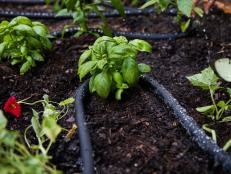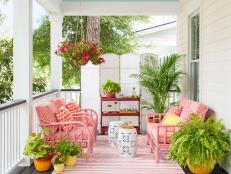Intensive Gardening Makes Small Spaces Work Double Time

Photo by Jane Coclasure courtesy of P. Allen Smith.
For most of us, the agrarian ideal—a traditional vegetable garden, with evenly spaced single rows gently curving over a large, rectangular plot—is neither possible nor practical. Thankfully, many far more productive and equally tested planting methods are accessible and achievable for today’s new crop of vegetable gardeners. Often described as intensive gardening methods, these practices help you produce more in less space.
Choose High-yield Crops
Planting crops that have a high yield per square foot makes better use of limited space. Tomatoes, peppers, onions, eggplant, beans, cucumbers and summer squash offer a lot of produce throughout the season from just a few plants. Also high-yielding, lettuce and greens are described as “cut-and-come-again” crops, meaning that you can cut the outer leaves continually through the growing season and the plant will continue to produce more leaves from the center. On the other hand, long vining crops such as melons, pumpkins and winter squash (such as butternut and acorn) require a lot of space for a relatively small harvest. One-harvest crops like cabbage and broccoli are also less efficient (though you can get second-harvest side-shoots from broccoli).
Plant Wide Rows
When you think about it more closely, the single-row method is really kind of a waste of space. The gaps between rows aren’t ripe for much beyond soil compaction (your feet are the culprits) and erosion. Instead, intensive gardeners will plant rows with two or three plants side-by-side, creating one wide double or triple row. This reduces the overall number of rows and the wasted space between them. Use the wide row method for all crops except vining plants like cucumbers and melons. It’s an especially lovely and useful practice for lettuce and greens like kale and chard.
Grow in Raised Beds
If you have limited space, poor soil or a bad back, raised beds are a great option. You can design a raised bed to be any shape or size, and make it out of almost any material, such as wood, rock, metal or even straw bales. The real advantage of raised beds lies in the middle, where you add loose, fluffy, deep soil, ideal for growing vegetables. Because the soil in raised beds is ideal, you can space plants more closely together than you can in native soil. I am constantly amazed at how much I can grow in one 4- x 8-foot raised bed.
Try Vertical Gardening
When you run out of space on the ground, grow up instead. Vining plants such as cucumbers, beans, peas, squash and tomatoes grow easily on trellises or fences, which can be made of anything from wood to bamboo to string. I’ve found that metal cattle panels (or hog panels, found at farm supply stores) make extra-sturdy trellises. Train the plant onto the trellis and secure it with twine. Some heavier fruits like melons will need extra support (usually a sling made from stretchy material such as old pantyhose) if grown vertically.
Plant Crops Together
A planting method called interplanting or intercropping helps you use space more efficiently. One idea is to plant fast-growing vegetables among slower-growing ones, such as radishes (faster) among carrots (slower), so that you harvest the fast crop before it begins to crowd the slow one. You also can plant low-growing crops that can take a little shade—such as lettuce, greens and cool-season herbs like parsley and chives—under tall crops like tomatoes and peppers, where the lower level will catch the rays that the taller plants let filter through.
Extend the Season
I’m always amazed at gardeners who pack it up at the end of August and think the gardening season is over until the following May or June. Spring and fall are arguably the best times to garden! By planting in all seasons, you get more annual harvest out of your space, which is the ultimate goal of intensive gardening. Having a plan for succession planting also helps extend the season and increase overall yields. For example, I plant peas in late winter for spring harvest, and then pull them up as the weather gets warm and they begin to wither. I replace them with peppers, which I’m prepared to cover in the case of a late frost. In mid to late summer, when I’ve had my fill of chilies, I take up the peppers and plant greens for fall and winter harvest.
Intensive Gardening in Containers
Containers are the ultimate solution for gardeners with limited space. While containers themselves aren’t really an intensive technique, you can employ intensive practices such as extending the season, vertical gardening and choosing high-yield crops and interplanting in your container garden. Some specialized containers, such as strawberry jars, also offer a kind of intensive planting because they allow you to grow from the top and the sides. Also look for compact new varieties of vegetable plants, such as cherry tomatoes, that were developed especially to suit small containers and even hanging baskets.

.-Battle-on-the-Beach-courtesy-of-HGTV.-.jpg.rend.hgtvcom.196.196.suffix/1714761529029.jpeg)












































